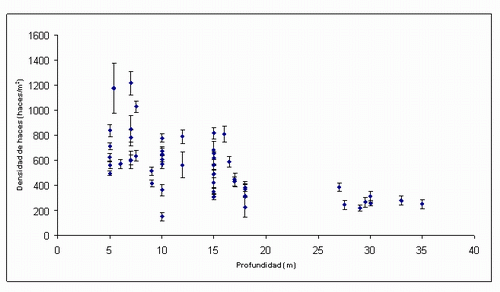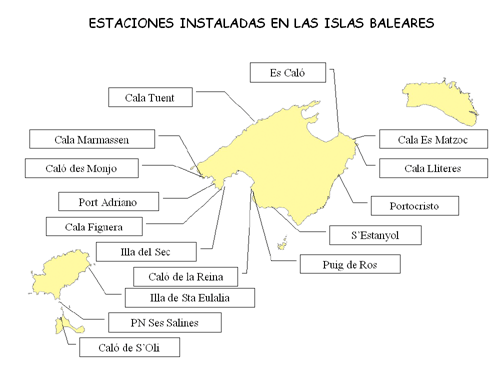Partner: Direcció general de Pesca.
Aims and planning:
To organize a monitoring network of volunteer divers from the various
diving clubs and diving schools in the Balearics. The goal was to encourage
divers to make a commitment to cooperate in the tasks of monitoring
the general state of this habitat along the coastline and detecting
new colonies of Caulerpa taxifolia.
An expert was to be put in charge of the daily functioning of the network
: providing necessary monitoring material and simple protocols while
at the same time encouraging participation by holding periodic meetings.
The aims of the network are:
1.- To evaluate the present state of Posidonia oceanica fields in the Balearics.
2.- To establish a Monitoring Network in collaboration with volunteer divers.
3.- Social involvement in the project. To organize a network of volunteers.
4.- To identify early indicators of decline in the fields.
Development:
Action E 4 was satisfactorily carried out exactly as it had been initially
previewed. The
“Red de Monitorización de las praderas de Posidonia en
Baleares” (Network for the Monintoring of Posidonia Fields in
the Balearics) was set up, based on volunteer divers whose help has
been invaluable in achieving the success of the project. When the project
started, at the beginning of 2002, lectures were given all over the
islands to explain the volunteer project and how interested persons
could participate. Numerous sport associations and diving centres came
to the lectures and many joined the volunteer network. Springing from
this first contact work groups were organized at each diving centre.
Volunteers met at their centre and were told of the importance of oceanic
Posidonia fields and instructed on the tasks they were to carry out.
Each volunteer was given a methodology guide and the necessary measuring
instruments. At the end of the meeting the outings were programmed,
and the number of these outings varied between one and three, depending
on the commitment—in terms of time and work--that each volunteer
was ready to make.
By the end of the project a total of 34 study-stations had been installed in the Balearics: 17 in Majorca, 13 in Minorca, 2 in Ibiza and 2 in Formentera. A total of 14 diving clubs participated: 9 in Majorca, 2 in Ibiza and 1 in Formentera. Apart from the clubs other entities also participated: Federación Balear de Actividades Subacuáticas (FBAS) (Balearic Federation of Subaquatic Activities), volunteers from the Protección Civil (Civil Protection), volunteer students from the UIB (University of the Balearics) and volunteers from the Fire-fighting Brigade. There was an specially intense collaboration with the Institut Menorquí d’Estudis (Minorcan Institute of Studies) (IME), together with whom the Minorca campaigns were carried out. In addition, the institutions representing the protected natural spaces of our autonomous community-- the three Natural Parks, cooperated in this effort: PN de Llevant, (Llevant Natural Park); PN de Ses Salines (Ses Salines Natural Park); and PN de Cala d´Hort (Cala d’Hort National Park); as well as the four marine reserves: RM Badia de Palma (Palma Marine Reserve); RM de Migjorn (Migjorn Marine Reserve); RM del Nord de Menorca (North Minorca Marine Reserve); and RM de Freus d´Eivissa i Formentera (Freus d’Eivissa i Formentera Marine Rerserve). Total participants were: 110 volunteer divers, plus staff from the diving clubs, park guards and guards at the marine reserves.
The creation of a Monitoring Network for Posidonia oceanica round the Balearic Islands was spawned by the need to determine the state of health of the plant and manage the habitat in order to preserve this valuable marine ecosystem.
This initiative is being implemented since 2002 thanks to the collaboration of diverse institutions, clubs, schools and concerned members of the public who are aware of the importance of protecting the environment in order to improve the state of the sea floor. In order to ensure the success of this project, commitment from all parties has been, is, and will continue to be vital. We encourage you to contact us and get the methodology guides (monitoring guide and guide of the leaves and fruits) and to participate in the important task of preserving one of the most determining ecosystems in the Mediterranean.
Lines of work
The Monitoring Network was organized with the aim of carrying out periodic controls at the sample collecting stations situated in Posidonia fields in SCI areas round the Balearics.
At these study-stations a series of environmental parameters about fields and the general environmental quality of the area are collected. These tasks can be done thanks to the volunteer cooperation of about 100 divers who gradually, with their interest, make this project possible.
The seasonal shedding of leaves of the Posidonia plant produces deposits of leaves along the coastline due to coastline dynamics ( currents and waves). These leaves play a fundamental role in maintaining the balance of beach sediment.
During blooming the success of pollination is determined and the result of the same is the appearance of fruits in the field, some of which are washed up on the beach. Counting and differentiating the fruits will help to determine the degree of viability of the same. That is why a network of volunteers – most of which are from the University of the Balearics-- has been organized.
Note: to obtain more
information about each study-station, simply click on the name of the
area where the station is situated.
Results:
Although we as yet have not obtained and compiled extensive data, the preliminary results show the following in terms of density of plant population at the various study-stations. It has been observed that there is a naturally occurring decrease in the density of plant population the deeper the waters over the field are, and this is because less sunlight reaches the plant. Nevertheless low population density has been observed in some fields where due to the depth of the water the plants should have been growing more densely. As we continue to collect data we may eventually be able to establish whether there are special factors causing this imbalance or whether the degree of density is normal in the area.

The above graph:
Shows the density of bushes in relation to the depth of the 34 study-stations
controlled so far.
Each year data on each established study-station has been compiled and
new study-stations have been set up throughout the islands. At the same
time, the parameters to be included have been widened in scope, taking
into account both results and the availability of volunteers. Thanks to
the implementation of Action E.4 we have succeeded not only in controlling
the Posidonia oceanica fields at the study-stations, but have also been
able to carry out extensive surveillance of the Balearic coastline as
a complement of Action D2, in the search for new colonies of Caulerpa
taxifolia and other invasive algae.
Action E.4 has satisfactorily been carried out throughout
the project and at present the Volunteer Network is well established on
the islands.
In the future regular control of all the study-stations is previewed as
well as the setting up of new study-stations on all the islands. The scope
of the parameters to be considered will also be widened taking into account
results obtained and volunteers’ availability.
Considering the degree to which monitoring has been implemented and the
quantity of data obtained thereof, it can be said that the initial aims
of this action have been fulfilled.
